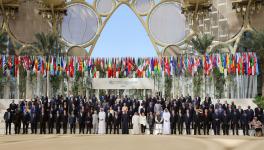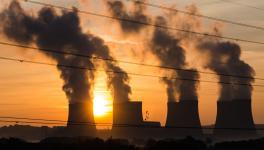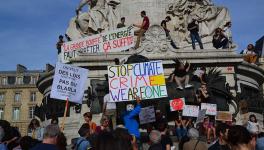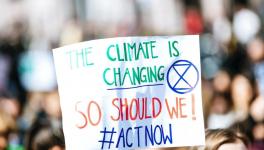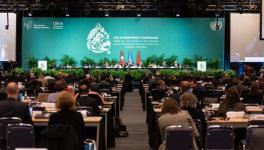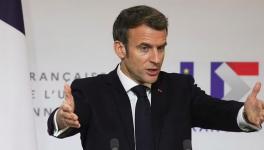COP22 at Marrakech: Uphill for the Third World in the Post-Paris Era-II
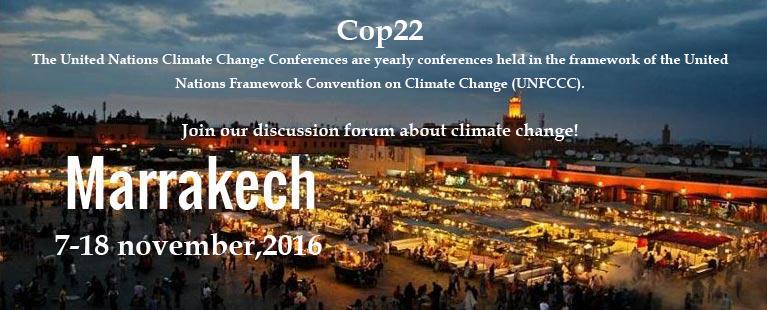
AS has been noted in the first part of this note, the emission reduction commitments made by the developed countries in the Paris Agreement are nowhere near enough to guarantee that global temperature increase will stay below 2 deg C over pre-industrial levels. At the same time, the agreement puts enormous pressure on the development of Third World nations (bar China of course) in terms of the energy options that are available to them at reasonable cost. But the story does not end there. In the Paris Agreement, the principle that the developed nations are responsible for taking the lead in drastic emissions reduction since the bulk of the greenhouse gas emissions in the atmosphere were put there by them in the first place was set aside definitively. Apart from setting aside this principle of historical responsibility, even in the paragraphs dealing with loss and damage due to “adverse effects associated to climate change, including extreme weather events and slow onset disasters”, the agreement made it clear that the developed nations did not consider that this provided any support to the notion of liability or compensation. In sum, apart from reminding the developed nations repeatedly, ad nauseum, of their promises there is little purchase or hold that the Third World appears to have on developed countries to force them to urgent and serious climate action.
STRIKING
CONTRAST
Nowhere was this more evident than in the discussions over the Doha Amendment to the Kyoto Protocol, which would extend the Kyoto Protocol into a second phase of emissions reduction to cover the period upto 2020. Under this amendment, a set of developed countries (different from the original list for the first phase) are committed to reducing emissions by 18 percent below 1990 levels in the period 2013 to 2020. After 2020, of course the Paris Agreement is expected to take over when it becomes operational. Ratifying the Doha amendment was also only one piece of a set of measures referred to as “enhanced pre-2020 actions” in the decision accompanying the Paris Agreement that was concurrently passed at COP21 at Paris last year. For the developing countries, enhanced ambition and action in emissions reduction and the provision of finance by the developed countries was the acid test of the genuineness of the developed world's commitment to meet their voluntary targets under the Paris Agreement. The Doha Amendment requires 144 countries to ratify it before its “entry into force”, a condition more onerous than that of the Paris Agreement, and to date only 74 countries have done so. The Kyoto Protocol is in many ways more stringent than the Paris Agreement in terms of the accountability of the developed countries (with legally binding reductions and not mere voluntary commitments which need only to be reported upon). So the reluctance to ratify the Doha Amendment in contrast to the speed of ratification of the Paris Agreement is indeed striking. Even the European Union (EU) has not yet ratified, held up by Poland, which wants the European Investment Bank to finance coal-fired power plants (the bank has officially stopped investment in new coal plants) in exchange for accepting the ratification!
At Marrakech the developed countries were remarkably reluctant to discuss further the whole issue of enhanced pre-2020 action. As the matter dragged on inconclusively in the first week of negotiations, the subject was referred for discussion to a so-called “facilitative dialogue” when high-level dignitaries from select countries would discuss the matter. This and the other “dialogue” on climate finance turned out to be damp squibs, substituting a vague, unclear workshop-style format that was not indeed expected to conclude anything but nevertheless replaced serious negotiations. The pre-2020 action dialogue was actually chaired by a senior Indian journalist (who of course did his duty as requested by the UNFCCC secretariat) but clearly it was an exercise that was not meant to go very far. Such dialogues and workshops have now begun to put in a much more frequent appearance in COP decisions whenever difficult issues are involved. At the end of the day, of course, matters have to be clinched and decisions arrived at, but this is done by intense, rapid fire consultations carried out at the last minute, at gunpoint as it were, racing to meet end-of-conference deadlines.
The other issue where the tactics of the developed country negotiators aroused the anger of developing country delegates, and even a large number of international and national NGOs from across the world, was that of climate finance. In a new report, the OECD, the developed countries' club, claimed that climate finance, to be provided by developed countries to developing nations for adaptation and mitigation, was well on track to reach the goal of 100 billion USD by 2020. However it was pointed out by critics that this was based on mixing up regular development assistance with climate finance (which developing countries insist should be “new” and “additional”) as well as clubbing together private equity flows as well as public funds from the developed world. The developing countries also insisted that adequate attention be paid to adaptation without overemphasising mitigation. Nevertheless this report was the basis that developed countries used while negotiating climate finance at COP22. A long wrangle on the subject dominated the entire summit. The resulting compromise resolution allowed the developed countries to stress the role of private sources of climate finance and their claims that the 100 billion dollar goal was on track to being realised, while retaining the pleas of the developing countries for more focus on adaptation and a greater role for public funding.
The overwhelming focus on climate finance on the part of many Third World nations, it must be noted, has become a problematic double-edged issue. On the one hand, for many smaller, poorer, and more vulnerable nations the need for adequate climate finance is urgent and clearly a necessity. But the increasing focus on this question also serves to draw attention away from putting adequate pressure on the developed nations to make a far more substantial effort on mitigation than they have committed so far. It must be recalled that from the days of the Copenhagen climate summit promising climate finance to vulnerable nations has become the strategy of the developed countries to break the unity of the ranks of the G-77 plus China group of Third World nations. So far the actual flows of finance have remained well below what has been claimed to be “committed” but the lure of finance continues to attract many Third World nations. Indeed this is what in part drove the negotiations at Paris last year, where many of them sided with the developed nations in determining the final form of the agreement, to the detriment of the core issue of adequate mitigation by the developed world. Such mitigation is of course the ultimate key to protecting the world from dangerous global warming.
The third significant issue at COP22 was the procedural aspects of implementing the Paris accord. It was agreed that the first meeting of the parties to the Paris Agreement, that began at Marrakech would be suspended, resumed at COP23 next year, and be concluded at COP24 in 2018. This would enable the implementation of the agreement to be concluded in the first meeting of parties to the agreement as its terms require. This issue too saw its share of wrangling. But in a pointer to the future, the passage of the final resolution was held up by a dispute that pitted developing countries against each other, with Brazil holding out on some questions, while China and India found themselves on the opposite side. Undoubtedly Brazil was backed by the developed countries but the fact that it was manifested overtly as a dispute among the developing countries (and within the BASIC grouping of Brazil, China, India and South Africa in particular) is not a happy augury for the future. The confrontation on substantive issues in implementing the Paris Agreement is yet to sharpen fully and will undoubtedly dominate the negotiations for the next two years.
LACKLUSTRE
PERFORMANCE
India's performance in the negotiations was lacklustre and its interventions meagre and weak. Post-Paris, New Delhi does not appear to have a well thought out game plan or a strategy. India's new leadership in the ministry of environment, forests and climate change (there have been many changes since Paris) spent a good deal of time on homilies about sustainable low-carbon lifestyles (including touting our poverty driven lifestyle as an exemplar of low-carbon living). Negotiators also called for climate justice in the implementation of the Paris Agreement without articulating any substantive detail to give some teeth to their arguments. In one critical discussion on the importance of pre-2020 action by developed countries, organised at the India pavilion, the Indian intervention was confined to a homily on teaching children not to waste food on their plates! It was left to the Bolivian minister present and a senior Third World Network climate policy expert to deal with the real issues.
Movements and NGOs too appear not to have grasped yet the full import of the Paris Agreement. Parallel to the summit, repeated manifestations were organised in support of the goal of limiting global temperature increase (over pre-industrial levels) to 1.5 deg C. But they seemed blissfully unaware that the goal is unattainable in sheer physical terms given the current commitments in the Paris Agreement. With Kerry's admission of the real intentions of the US in promoting the agreement (described in part I of this note) the demand for 1.5 deg C appears even more unreal – but of this there was little sign in the sloganeering. In another session, scientists from a group of countries tried to argue that a pathway of emissions reduction to a 1.5 deg C goal was possible, but they glossed over the fact that their scenarios required significant amounts of negative greenhouse gas emissions post 2050. Negative emissions are the arena of much scientific speculation but to argue their role as part of a viable scenario for the future is nothing short of deliberate misrepresentation.
The Paris Agreement, it is clear, does not represent an opening or a window of opportunity for developing countries. Indian officialdom is aware of this, in contrast to many developing countries obsessed with climate finance, but without as yet a strategy for the future. It is still extremely important to ensure that the detailed implementation of the agreement does not worsen the situation for the Third World and that the best possible deal, under conditions of limited manoeuvrability, is yet obtained. But that is going to be a hard and uphill task that requires careful evaluation of all the scientific, technological, economic and political options that are available at the current juncture.
Disclaimer: The views expressed here are the author's personal views, and do not necessarily represent the views of Newsclick.
Get the latest reports & analysis with people's perspective on Protests, movements & deep analytical videos, discussions of the current affairs in your Telegram app. Subscribe to NewsClick's Telegram channel & get Real-Time updates on stories, as they get published on our website.









